#syntactic structures
Explore tagged Tumblr posts
Text
The Philosophy of Syntax
The philosophy of syntax is a branch of philosophy that examines the fundamental principles and structures underlying the organization of language at the level of syntax. Syntax is concerned with the rules and principles governing the arrangement of words into phrases, clauses, and sentences to convey meaning and communicate effectively.
Key aspects of the philosophy of syntax include:
Universal Grammar: The philosophy of syntax often engages with the concept of universal grammar, which posits that humans are innately predisposed to acquire language and that there are underlying structural principles shared by all languages. Philosophers explore questions about the nature and source of universal grammar and its implications for linguistic theory.
Grammar and Rules: Philosophers analyze the nature of grammatical rules and constraints that govern sentence formation in natural languages. They examine questions such as whether there are innate syntactic rules, how syntactic structures are generated and interpreted, and the relationship between syntax and semantics.
Syntactic Categories and Structures: The philosophy of syntax investigates the categorization and hierarchical structure of linguistic elements such as words, phrases, and clauses. Philosophers explore the principles underlying the classification of syntactic categories (e.g., nouns, verbs, adjectives) and the hierarchical organization of syntactic structures (e.g., phrase structure trees, constituency relations).
Syntactic Variation and Change: Philosophers study syntactic variation and change across languages and over time. They investigate the factors that influence syntactic variation, such as social factors, contact between languages, and language acquisition processes. Philosophers also explore theories of syntactic change and the mechanisms by which syntactic structures evolve.
Syntactic Interfaces: The philosophy of syntax examines the interfaces between syntax and other components of grammar, such as semantics, phonology, and morphology. Philosophers investigate how syntactic structures interface with these other components to generate meaning and produce speech sounds.
Syntactic Universals and Typology: Philosophers explore the existence of syntactic universals—patterns and principles that are found across languages—and their implications for linguistic theory. They also investigate language typology, which involves the classification and comparison of syntactic structures across languages to identify cross-linguistic patterns and regularities.
Computational Syntax: The philosophy of syntax engages with computational approaches to syntax, which use formal and computational models to describe and analyze syntactic structures. Philosophers examine the role of computational methods and theories in understanding syntactic phenomena and modeling language processing.
Overall, the philosophy of syntax offers insights into the fundamental principles governing the structure of language and provides a theoretical framework for understanding syntactic phenomena across different languages and linguistic contexts.
#philosophy#epistemology#knowledge#learning#chatgpt#ontology#education#metaphysics#psychology#Syntax#Universal Grammar#Grammatical Rules#Syntactic Categories#Syntactic Structures#Syntactic Variation#Syntactic Change#Syntactic Interfaces#Syntactic Universals#Computational Syntax
1 note
·
View note
Text
It is very nice to see a movie entirely in French and comprehend what they say before glancing at the English subs.
#like yes i am in fact able to do this#and i noticed when the spoken french had to be rephrased in the english because of syntactic structures and stuff
5 notes
·
View notes
Note
thinking of you and sending one billion hugs
thinking of you back and returning one billion hugs....... i have just been on a train for 5 hours and slowly but surely entering psychic combat with chomsky's government and binding theory. we got invisible pronouns up in this bitch
#i am somehow still doing finals#they're take home essays which is great but the deadlines are. not so great#i spent a full 30 minutes on that train journey desperately looking for if big PRO (invisible pronoun) adhered to binding principle A or B#it was painful on my brain i had to have COHERENT THOUGHT (to my knowledge it should be binding principle A due to the fact that it takes#gender/case/number features from the local antecedent and is bound/c-commanded within the clausal range)#and now i move onto x-bar theory in the syntactical tree structure of grammatical utterances. for reference this is the easiest out of all#i have to do. fun!!!!!#i miss you my friend i hope to return to being able to talk more soon!!! and i hope you are good!!!#i have seen so much of your lovely art on my dash and i literally made a note to go and reblog it soon#i am waiting to do it because i am going to leave so much stuff in the tags it will actually take focus and effort#one million love and happiness for you forever
3 notes
·
View notes
Text
just had a conversation for like 10 minutes straight and am very shaky but still operational everyone be proud of me
#it had small talk and everything#I genuinely feel the adrenaline over having just participated in a conversation#(anyways I have a singular classmate who is nice and talked to me this is a victory in my books#we talked about class and learning languages and he explained the syntactic structure of japanese to me#and then I talked about inventing my own syntactic structure in french class that one time#it was a great conversation with a fellow linguistics major had great fun#even remembered to ask for his name!#this is. such a win for the local pandalion actually#beating the scared of conversations allegations one conversation at a time#anyways nobody talk to me for a month I need to recuperate this was exhausting-)
0 notes
Text
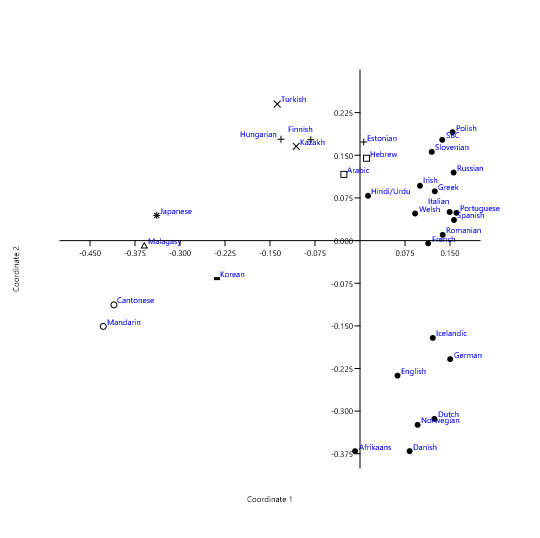
i love getting to make leetol pictures for my dissertation
#it is not Entirely clear to me what this leetol picture actually means#the principle coordinate analysis produced. 32 coordinates. of which these are the two which account for the most variance#i am not really sure what if they can be said to correlate to anything in the structure of these languages#the pcoa having been performed upon a distance matrix derived from a set of syntactic parameters#it sorta looks like coordinate 2 has some association with 'analyticity'?#coordinate 1 looks broadly like. indo-europeanness. dunno what that specifically could be.#idk it might all be Nothing and my supervisor might tell me to take it out#dissertationposting
1 note
·
View note
Text
How does one describe the process of compounding in morphology?
Compounding is a morphological process by which two or more individual words are combined to create a new word with its own distinct meaning. This process is used in many languages around the world, and it is an important aspect of word formation in morphology. In this article, we will describe the process of compounding in morphology, including its types, formation, and examples. Continue…

View On WordPress
#bound morphemes#Compounding#constituent morphemes#direct compounding#free morphemes#homophones#hyphenated compounding#internal structure of words#linguistic irregularities#Morphology#neologisms#open compounding#semantic analysis#syntactic analysis
0 notes
Text
Writing Notes: Children's Dialogue
Language is extremely complex, yet children already know most of the grammar of their native language(s) before they are 5 years old.
BABBLING
Babbling begins at about 6 months and is considered the earliest stage of language acquisition
By 1 year babbles are composed only of the phonemes used in the language(s) they hear
Deaf babies babble with their hands like hearing babies babble using sounds
FIRST WORDS
After the age of one, children figure out that sounds are related to meanings and start to produce their first words
Usually children go through a holophrastic stage, where their one-word utterances may convey more meaning
Example: "Up" is used to indicate something in the sky or to mean “pick me up”
Most common first words (among the first 10 words uttered in many languages): “mommy,” “daddy,” “woof woof,” “no,” “bye,” “hi,” “yes,” “vroom,” “ball” and “banana”
WORD MEANINGS
When learning words, children often overextend a word’s meaning
Example: Using the word dog to refer to any furry, four-legged animal (overextensions tend to be based on shape, size, or texture, but never color)
They may also underextend a word’s meaning
Example: Using the word dog to refer only to the family pet, as if dog were a proper noun
The Whole Object Principle: When a child learns a new word, (s)he is likely to interpret the word to refer to a whole object rather than one of its parts
SYNTAX
At about two years of age, children start to put words together to form two-word utterances
The intonation contour extends over the two words as a unit, and the two-word utterances can convey a range of meanings:
Example: "mommy sock" = subject + object or possessive
NOTE: Chronological age is NOT a good measure of linguistic development due to individual differences, so instead linguists use the child’s mean length of utterance (MLU) to measure development
The telegraphic stage describes a phase when children tend to omit function morphemes such as articles, subject pronouns, auxiliaries, and verbal inflection
Examples: "He play little tune" or "Andrew want that"
Between 2;6 and 3;6 a language explosion occurs and children undergo rapid development
By the age of 3, most children consistently use function morphemes and can produce complex syntactic structures:
Examples: "He was stuck and I got him out" / "It’s too early for us to eat"
After 3;6 children can produce wh-questions, and relative pronouns
Sometime after 4;0 children have acquired most of the adult syntactic competence
PRAGMATICS
Deixis: Children often have problems with the shifting reference of pronouns
Children may refer to themselves as "you"
Problems with the context-dependent nature of deictic words: Children often assume the hearer knows who s/he is talking about
AUXILIARIES
In the telegraphic stage, children often omit auxiliaries from their speech but can form questions (with rising intonation) and negative sentences
Examples: "I ride train?" / "I not like this book"
As children acquire auxiliaries in questions and negative sentences, they generally use them correctly
SIGNED LANGUAGES
Deaf babies acquire sign language in the same way that hearing babies acquire spoken language: babbling, holophrastic stage, telegraphic stage
When deaf babies are not exposed to sign language, they will create their own signs, complete with systematic rules
IMITATION, REINFORCEMENT, ANALOGY
Children do imitate the speech heard around them to a certain extent, but language acquisition goes beyond imitation
Children produce utterances that they never hear from adults around them, such as "holded" or "tooths"
Children cannot imitate adults fully while acquiring grammar
Example:
Adult: "Where can I put them?" Child: "Where I can put them?"
Children who develop the ability to speak later in their childhood can understand the language spoken around them even if they cannot imitate it
NOTE: Children May Resist Correction
Example: Cazden (1972) (observation attributed to Jean Berko Gleason) – My teacher holded the baby rabbits and we patted them. – Did you say your teacher held the baby rabbits? – Yes. – What did you say she did? – She holded the baby rabbits and we patted them. – Did you say she held them tightly? – No, she holded them loosely.
Another theory asserts that children hear a sentence and then use it as a model to form other sentences by analogy
But while analogy may work in some situations, certainly not in all situations:
– I painted a red barn. – I painted a barn red. – I saw a red barn. – I saw a barn red.
Children never make mistakes of this kind based on analogy which shows that they understand structure dependency at a very young age
BIRTH ORDER
Children’s birth order may affect their speech.
Firstborns often speak earlier than later-born children, most likely because they get more one-on-one attention from parents.
They favor different words than their siblings.
Whereas firstborns gabble on about animals and favorite colors, the rest of the pack cut to the chase with “brother,” “sister,” “hate” and such treats as “candy,” “popsicles” and “donuts.”
The social dynamics of siblings, it would appear, prime their vocabularies for a reality different than the firstborns’ idyllic world of sheep, owls, the green of the earth and the blue of the sky.
MOTHER'S LEVEL OF EDUCATION
Children may adopt vocabulary quite differently depending on their mother’s level of education.
In American English, among the words disproportionately favored by the children of mothers who have not completed secondary education are: “so,” “walker,” “gum,” “candy,” “each,” “could,” “wish,” “but,” “penny” and “be” (ordered starting with the highest frequency).
The words favored by the children of mothers in the “college and above” category are: “sheep,” “giraffe,” “cockadoodledoo,” “quack quack,” the babysitter’s name, “gentle,” “owl,” “zebra,” “play dough” and “mittens.”
BOYS / GIRLS
One area of remarkable consistency across language groups is the degree to which the language of children is gendered.
The words more likely to be used by American girls than by boys are: “dress,” “vagina,” “tights,” “doll,” “necklace,” “pretty,” “underpants,” “purse,” “girl” and “sweater.”
Whereas those favored by boys are “penis,” “vroom,” “tractor,” “truck,” “hammer,” “bat,” “dump,” “firetruck,” “police” and “motorcycle.”
Tips for Writing Children's Dialogue (compiled from various sources cited below):
Milestones - The dialogue you write should be consistent with the child's developmental milestones for their age. Of course, other factors should be considered such as if the child has any speech or intellectual difficulties. Also note that developmental milestones are not set in stone and each child is unique in their own way.
Too "Cutesy" - If your child characters are going to be cute, they must be cute naturally through the force of their personality, not because the entire purpose of their existence is to be adorable.
Too Wise - It’s true kids have the benefit of seeing some situations a little more objectively than adults. But when they start calmly and unwittingly spouting all the answers, the results often seem more clichéd and convenient than impressive or ironic.
Unintelligent - Don’t confuse a child’s lack of experience with lack of intelligence.
Baby Talk - Don’t make a habit of letting them misuse words. Children are more intelligent than most people think.
Unique Individuals - Adults often tend to lump all children into a single category: cute, small, loud, and occasionally annoying. Look beyond the stereotype.
Personal Goals - The single ingredient that transforms someone from a static character to a dynamic character is a goal. It can be easy to forget kids also have goals. Kids are arguably even more defined by their goals than are adults. Kids want something every waking minute. Their entire existence is wrapped up in wanting something and figuring out how to get it.
Don't Forget your Character IS a Child - Most of the pitfalls in how to write child characters have to do with making them too simplistic and childish. But don’t fall into the opposite trap either: don’t create child characters who are essentially adults in little bodies.
Your Personal Observation - To write dialogue that truly sounds like it could come from a child, start by being an attentive listener. Spend time around children and observe how they interact with their peers and adults. You can also study other pieces of media that show/write about children's behaviour (e.g., documentaries, films, TV shows, even other written works like novels and scripts).
Context - The context in which children speak is crucial to creating realistic dialogue. Consider their environment, who they're speaking to, and what's happening around them. Dialogue can change drastically depending on whether a child is talking to a friend, a parent, or a teacher. Additionally, children's language can be influenced by their cultural background, family dynamics, and personal experiences. Make sure the context informs the dialogue, lending credibility to your characters' voices.
Sources and other related articles: 1 2 3 4 5 6 7 8 9 10
Writing Notes: On Children ⚜ Childhood Bilingualism More: Writing Notes & References
#writing prompt#writeblr#writers on tumblr#spilled ink#poets on tumblr#writing notes#children#writing tips#literature#writing advice#writing reference#studyblr#langblr#linguistics#dark academia#dialogue#writing resources
3K notes
·
View notes
Photo
[Image description: The first image is a screenshot of the first five sections of Inger Christensen's poem "Alphabet," translated from Danish into English by Susanna Nied. The second image is a screenshot of the first seven sections of the original poem, "Alfabet." /end ID]
and see an interesting interview with the translator here and here. you can read an excerpt from the original and the translation of that excerpt (via the link at the top of that page) here.

#continuing to have many thoughts about poetry in translation#because like i loved the excerpt in english when i saw this post on my dash. then i went into the notes for an ID#and instead found this reblog which reveals this is a translation of a poem written in danish#and the things i loved about the english poem are different in the original. they are in a sense different poems#poetry#translation#sorry for the incomplete description but i figured it is better than nothing#also! excerpts of poems are not the same as poems in their entirety!#reading an excerpt of a poem is no less a poetic experience than reading the whole poem#but you are reading what is essentially a different work. it's certainly a related work but it is not the same#a poem is a cohesive whole...removing part of it will always lose or change some of its essence#did you know this poem is structured on the fibonacci sequence and speaks to the threat of nuclear war?#i mean i certainly didn't pick up on either of those things just by reading the first five sections#though now that i know that i understand what hydrogen is doing in the b section (it's not just because hydrogen in danish starts with b)#now i'd really like a version of this poem with danish on one side and the translation on the other#i feel like i know just enough about danish that i could possibly get something out of that#especially with a poem with so much syntactic repetition
10K notes
·
View notes
Text
On the Identity of "Chat"
Like all the linguistics folks on Tumblr, I've been sent the "chat is a fourth person pronoun" post by a bunch of well-meaning people and and I've been thinking waaay too much about it. @hbmmaster made a wonderful post explaining exactly why "chat" ISN'T a fourth person pronoun, and after reading it I wanted to go a little deeper on what it might actually be doing linguistically, because it is a really interesting phenomenon. Here's a little proposal on what might be going on, with the caveat that it's not backed up by a sociolinguistic survey (which would be fun but more than I could throw together this morning).
On Pronouns
Studying linguistics has been really beneficial for me because understanding that language is constantly changing helped me to become comfortable with using they/them pronouns for myself. I've since done a decent amount of work with pronouns, and here are some basic ideas.
A basic substitution test shows that "chat" is not syntactically a pronoun: it can't be replaced with a pronoun in a sentence.
"Chat, what do we think about that?"
"He*, what do we think about that?" (* = ungrammatical, a native speaker of English would think it sounds wrong)
Linguists identify pronouns as bundles of features identifying the speaker, addressee, and/or someone outside the current discourse. So, a first person pronoun refers to the speaker, a second person pronoun refers to the addressee, and a third person pronoun refers to someone who is neither the speaker nor the addressee (but who is still known to the speaker and addressee). This configuration doesn't leave a lot of room for a "fourth" person. But the intuition people have that "chat" refers to something external to the discourse is worth exploring.
Hypothesis 1: Chat is a fourth-person pronoun.
We've knocked this one right out.
Hypothesis 2: Chat is an address term.
So what's an address term? These are words like "dude, bro, girl, sir" that we use to talk to people. In the original context where "chat" appears - streamers addressing their viewers - it is absolutely an address term. We can easily replace "chat" with any of these address terms in the example sentence above. It's clear that the speaker is referring to a specific group (viewers) who are observing and commenting on (but not fully participating in) the discourse of the stream. The distinction between OBSERVATION and PARTICIPATION is a secret tool that will come in handy later.
But when a student in a classroom says "wow chat, I hate this," is that student referring to their peers as a chat? In other words, is the student expecting any sort of participation or observation by the other students of their utterance? Could "chat" be replaced with "guys" in this instance and retain its nuance? My intuition as a zillenial (which could be way off, please drop your intuitions in the comments) is that the relationship between a streamer and chat is not exactly what the speaker in this case expects out of their peers. Which brings me to...
Hypothesis 3: chat is a stylistic index.
What's an index in linguistics? To put it very simply, it's anything that has acquired a social meaning based on the context in which it's said. In its original streaming context, it's an address term. But it can be used in contexts where there is not a chat, or even any group of people that could be abstracted into being a chat. Instead, people use this linguistic structure to explicitly mimic the style which streamers use.
And that much seems obvious, right? Of course people are mimicking streamers. It doesn't take a graduate degree to figure that out. What's interesting to me is why people choose to employ streaming language in certain scenarios. How is it different from the same sentence, minus the streamer style?
This all comes down to the indexicality, or social meaning, of streamer speak. This is where I ask you all to take over: what sorts of attitudes and qualities do you associate with that kind of person and that kind of speech? I think it has to do with (here it comes!) the PARTICIPANT/OBSERVER distinction. By framing speech as having observers, a speaker takes on the persona of someone who is observed - a self-styled celebrity. To use "chat" is to position oneself as a celebrity, and in some cases even to mock the notion of such a position. We can see a logical path from how streamers use "chat" as an address term to how it is co-opted to reference streamer culture and that celebrity/observer relationship in non-streaming mediated discourse. If we think about it that way, then it's easy to see why the "fourth person pronoun" post is so appealing. It highlights a discourse relationship that is being invoked wherein "chat" is not a group but a style.
1K notes
·
View notes
Note
I feel like we see new verbs adjectives and nouns pop up all the time. Are there any examples of new conjunctions or prepositions (or similar) being made?
function words like conjunctions and prepositions fall into what we call "closed lexical categories" - they're very resistant to innovation, being so integral to syntactic structure. verbs, adjectives, and nouns are all open categories and readily accept new forms.
202 notes
·
View notes
Note
Hi! Quick High Valyrian translation request: I was wondering how you would translate this sentence: "You don't look well, father."
(Context: a character seeing their dad for the first time in a while and noticing that they look tired/a bit haggard)
I did try looking on the wiki dictionary for a verb like "to look", "to appear", or "to seem __" but didn't find anything that seemed right — sorry if it is there and I just missed it, though!
Thanks for your help :D
This needs to be recast as "You are not well it seems, father". That might make it easier. A little syntax discussion. In English, verbs like "seem" can be tricksy. You can say both of the following with roughly the same meaning:
You seem to hate onions.
It seems (that) you hate onions.
Slight differences in meaning aside, it's the syntactic difference I want to draw attention to. In sentence (1), "seem" is the main verb of the sentence and "you" is its subject. "You" is also the subject of the nonfinite clause "to hate onions". In (2), however, that entire thought is rendered as a subordinate clause. Now it's "you hate onions", which is subordinated by "that" (which can be omitted), which is governed by this matrix clause "It seems". Now "seems" is the matrix verb, its subject "it", but "it" doesn't meant anything. It's a dummy subject (or expletive) that is required because English clauses require a subject.
Whatever your syntactic theory, something in the English language allows both of these structures to exist. Not all languages allow for this. High Valyrian is one that does not.
The verb vestragon which means, ordinarily, "to tell" can be used to mean "to seem". Crucially, though, it can never be used in the manner of (1) above in English. In fact, if you think about the original meaning, you can see how there would be very little sense in it. Taking that sentence (1) and translating it literally:
Zāliapossa buqagon vestrā. "You say to hate onions."
It wouldn't make any sense for this to end up meaning "It seems you hate onions" or "You seem to hate onions". Of course it would seem that way if you were saying it! There's no seem about it!
Instead, the way things work in High Valyrian is usually "Here's the main thing in question, now here's a comment about it". And that is, indeed, why vestragon came to mean "to seem". It does so like this:
Zāliapossa buqō vestras. "It seems you hate onions."
That is "Onions you hate, it says". Now that "it" doesn't refer to anyone in particular. It's that dummy subject again. But it's not required in Valyrian. In Valyrian it's enough to have the clause (with a verb in the subjunctive) and then vestras at the end. It's a bit like saying "it is said" or "one says" or "it is heard" or the like. Another way of thinking of it is saying "The situation or my pereceptions tell that you hate onions". In fact, you can actually say as much, by adding a pronoun in the dative:
Zāliapossa buqō ynot vestras. "It seems to me you hate onions."
That is "Onions you hate, to me it says".
Now, back to your original question.
"You don't look well, father" should be reacast as, "You are not well it seems, father". That would be:
Rytsa iksō daor vestras, kepus.
That is, "Well you are not it seems, father".
And there you have it. Thanks for the ask!
236 notes
·
View notes
Text
That was...... too easy......
Final exam of the semester, hi 🥰

#wdym the last excercise was just finding the syntactical structure of three perifrasis verbales#oh well#let's fucking go? i guess?
4 notes
·
View notes
Text
Matter is tangible, so is a word, memory of a word, or spoken word. Given a word is tangible, it must be encoded in physical matter. Given it is encoded in physical matter, any physical matter can techinqually econde or represent a word. Encoded matter can encode a word that is only defined by cultural evolution and the range of a language. Other forms of communicaiton life scent in ants or touch is determined by causal branch chains of increasing compexity and diversity of cultural collectors
The concept that language, in all its forms, is encoded in physical matter opens up a fascinating perspective on communication and its evolution. This view aligns with the broader understanding that all forms of communication, whether linguistic or otherwise, are fundamentally grounded in the physical world and shaped by both biological imperatives and cultural evolution.
https://auckland.academia.edu/JeremyMarkman Given quantum gravity being information as energy as discrete units of mass across casual time. Define language as matter on a 1:1 model of itself but able to be perceived and translocated to perception
In a framework where quantum gravity is conceptualized as information manifesting as discrete units of energy and mass across causal time, language can be modeled as matter in a unique and profound way. This model posits language not merely as a system of communication but as a fundamental entity that parallels the physical properties of matter, capable of being perceived and translocated to perception. Here’s how this can be conceptualized:
1. Language as Matter: In this model, each unit of language (be it a word, phrase, or syntactic structure) is treated as a discrete unit of matter. Just as matter is composed of atoms, language is composed of these fundamental linguistic units. These units have mass in a metaphorical sense—they carry "weight" in terms of meaning and impact on the listener or reader. They occupy "space" within the medium they are used (spoken in the air, written on paper, displayed on screens) and have a "density" determined by their complexity and the depth of the concepts they convey.
2. Language as Perceptible and Translocatable: Language, like matter, can change states and be translocated from one medium to another while retaining its fundamental properties. For example, a spoken word (a sound wave traveling through air) can be transcribed into text (symbols on paper) and then digitized (data in a computer system). Throughout these transformations—akin to phase changes in matter—the core content, or the "mass" of the language, remains consistent, preserving the integrity of the information conveyed.
3. Language in Causal Time: Incorporating the concept of causal time, language can be seen as operating within and across time, influencing and being influenced by the context in which it is used. Just as particles interact in fields according to the laws of physics, linguistic units interact within the fields of human cognition and culture, shaped by past usage and shaping future communication. This interaction can be thought of as a form of linguistic gravity, where denser (more meaningful or complex) units of language have a stronger pull and can significantly alter the trajectory of a conversation or discourse.
4. Language as Information and Energy: Drawing from the idea that quantum gravity treats information as energy, language in this model can be seen as a form of energy transfer. When language is used, it transmits energy—in the form of ideas, emotions, and intentions—from one mind to another. This transmission can do work in the psychological sense, affecting changes in understanding, belief, or emotion, much like how energy in the physical sense can affect changes in the state or motion of matter.
5. Perception and Translocation of Language: Finally, the perception of language involves the decoding of these linguistic units of matter by the brain, a process that converts the "latent energy" of language into meaningful cognitive constructs. The ability of language to be translocated to perception involves its capacity to be understood and internalized by a receiver, who then converts it into thought and potentially into further linguistic output, continuing the cycle of information exchange.
In summary, defining language as matter on a 1:1 model of itself but able to be perceived and translocated to perception provides a rich, multidimensional way to understand communication. It highlights the tangible, impactful nature of language and aligns linguistic processes with fundamental physical principles, offering a holistic view of how language operates within and shapes our understanding of reality.
1. Tangibility of Language: When considering language as tangible, we recognize that words, whether written, spoken, or remembered, are manifestations of physical processes. Spoken words are sound waves, shaped by the movement of air through physical structures in the body. Written words are visual symbols, represented by ink on paper or pixels on a screen. Even memories of words are encoded in the neural pathways and synaptic connections within the brain. Thus, every aspect of language is tied to physical matter.
2. Encoding of Words in Physical Matter: The encoding of words in physical matter suggests that any material object could potentially represent or encode language, given the right contextual framework. For instance, a series of marks on a stone could encode a message if interpreted by someone who understands the markings within a cultural or linguistic context. This encoding is not limited to traditional forms of writing but can extend to any form of matter that can be manipulated to carry meaning, such as digital data formats, patterns in nature, or even arrangements of objects.
3. Cultural Evolution and Language Definition: The meanings of words and the structures of languages are not static but evolve over time through cultural processes. As societies change, so do their languages, adapting to new realities and integrating new concepts. This cultural evolution affects how language is encoded in matter, as the physical representations of language (such as alphabets, lexicons, and syntax) must evolve to accommodate new meanings and uses. The diversity of languages across cultures exemplifies how different groups of people have developed unique ways to encode their communication into physical forms.
4. Non-Linguistic Forms of Communication: Exploring non-linguistic forms of communication, such as the scent trails followed by ants or the tactile communication among animals, reveals that these too are encoded in physical matter through chemical signals or physical interactions. These forms of communication are governed by their own complex rules and can be seen as having their own 'grammars' or systems, shaped by the evolutionary needs of the species and the environmental contexts in which they operate.
5. Causal Chains and Cultural Collectors: The development of communication systems, whether linguistic or non-linguistic, can be viewed as the result of causal chains where each adaptation builds upon previous capabilities, influenced by environmental pressures and opportunities. Cultural collectors, such as societies or colonies, gather and refine these communication methods, leading to increasing complexity and diversity. These collectors serve as repositories and incubators for the cultural evolution of communication, ensuring that effective methods are preserved and transmitted through generations.
Understanding language and communication as phenomena encoded in physical matter, shaped by both biological imperatives and cultural evolution, provides a comprehensive framework for exploring how diverse forms of communication arise, function, and adapt over time. This perspective highlights the interconnectedness of physical reality, biological life, and cultural development in shaping the ways in which living beings convey information and meaning.
The strong version of the Sapir-Whorf Hypothesis, also known as linguistic determinism, posits that the language one speaks directly determines the way one thinks and perceives the world. This hypothesis suggests that language is not merely a tool for communication but a constraining framework that shapes cognitive processes, categorization, and even perception and memory.
Correlation with Language as Encoded in Physical Matter:
Language as a Deterministic Framework: If we accept that language is encoded in physical matter, and that this encoding extends to the neural circuits and structures within the brain, then the strong Sapir-Whorf Hypothesis suggests that these physical structures (shaped by language) directly influence how individuals conceptualize and interact with their environment. The neural encoding of linguistic structures would thus predetermine the range of cognitive processes available to an individual, supporting the idea that language shapes thought.
Cultural Evolution and Linguistic Diversity: The diversity of languages and the way they are physically encoded (in scripts, sounds, or digital formats) reflect different cognitive frameworks developed across cultures. Each linguistic system, evolved and encoded differently, offers unique categories and concepts that shape the thoughts and behaviors of its speakers. For instance, the presence or absence of certain words or grammatical structures in a language can influence how speakers of that language perceive time, space, or even social relationships.
Physical Encoding of Non-Linguistic Communication: Extending the concept of linguistic determinism to non-linguistic forms of communication (like pheromones in ants or tactile signals in other species) suggests that these communication methods, though not linguistic, are similarly encoded in the physical entities (chemicals, body structures) and influence the behavior and social structures of these species. Just as language restricts and enables human thought, these communication systems define the perceptual and interactional possibilities for other organisms.
Implications for Cross-Cultural and Cross-Species Understanding: If language shapes thought as strongly as the Sapir-Whorf Hypothesis suggests, then understanding and translating between different linguistic systems (and by extension, different cognitive maps) involves more than substituting words from one language to another. It requires an understanding of the underlying physical and cognitive structures that produce these languages. Similarly, interpreting non-human communication systems in terms of human language might miss essential aspects of these systems' meanings and functions.
Language, Thought, and Reality Construction: The encoding of language in physical matter, particularly in neural structures, implies that changes in language use—whether through cultural evolution, personal learning, or technological augmentation—can lead to changes in these physical structures. This neuroplasticity, driven by linguistic variation, supports the idea that not only does language determine thought, but that altering language can alter thought and potentially perception of reality itself.
Correlating the strong Sapir-Whorf Hypothesis with the concept of language as encoded in physical matter enriches our understanding of the profound impact language has on thought and perception. It underscores the intertwined nature of linguistic structures, cognitive processes, and the physical substrates that support them, highlighting the deep influence of language on individual and collective worldviews.
Follow up with comsological evolution and the strong anthropromoprhic prinicple
The strong anthropic principle posits that the universe must have properties that allow life to develop at some stage in its history, specifically because observers (like humans) exist. This principle suggests that the universe's fundamental parameters are finely tuned in a way that makes the emergence of observers inevitable. When considering cosmological evolution—the development and changes of the universe over time—this principle can lead to profound implications about the nature of the universe and its laws.
Correlation with Cosmological Evolution:
Fine-Tuning of Universal Constants: The strong anthropic principle implies that the constants and laws of physics are not arbitrary but are set in such a way as to allow the emergence of complex structures, including life. For example, the specific values of the gravitational constant, the electromagnetic force, and the cosmological constant are such that they allow galaxies, stars, and planets to form, creating environments where life can develop. This fine-tuning is seen as necessary for the universe to evolve in a way that eventually produces observers.
Evolution of Complexity: From the perspective of cosmological evolution, the universe has undergone a series of stages that increase in complexity: from the Big Bang, through the formation of hydrogen and helium, to the synthesis of heavier elements in stars, and finally to the formation of planets and biological evolution on at least one of them (Earth). The strong anthropic principle suggests that this progression towards complexity is a fundamental feature of the universe, driven by the underlying need to create a context in which observers can eventually exist.
Multiverse and Observer Selection: One way to reconcile the apparent improbability of such fine-tuning is through the multiverse theory, which posits the existence of many universes, each with different physical constants and laws. In this framework, the strong anthropic principle can be understood through an observer selection effect: we find ourselves in a universe that allows our existence because only such universes can be observed by sentient beings. This ties the evolution of the cosmos not just to physical laws but to the very presence of observers who can contemplate it.
Implications for Fundamental Physics: The strong anthropic principle challenges physicists to think about fundamental laws in a new light. Rather than seeing the laws of physics as universally applicable and inevitable, this principle suggests that they might be part of a larger landscape (possibly within a multiverse) where different laws apply under different conditions. This perspective could drive new theories in physics that seek to explain why our particular set of laws supports the complexity necessary for life and observers.
Philosophical and Theological Implications: The strong anthropic principle blurs the lines between science, philosophy, and theology. It raises questions about the purpose and intent of the universe, suggesting a teleological aspect to cosmological evolution. This can lead to philosophical debates about the nature of existence and the possibility of a higher purpose or design behind the unfolding of the universe.
In conclusion, when considering the strong anthropic principle in the context of cosmological evolution, we are led to view the universe not just as a series of physical events unfolding over time, but as a process that is somehow oriented towards the creation of life and observers. This perspective invites a broader understanding of the universe, one that incorporates the conditions necessary for life and consciousness as integral to the cosmic evolution itself.
161 notes
·
View notes
Text
I’m once again returning to do god’s work by bringing you delightful moments from Spock’s World by Diane Duane.
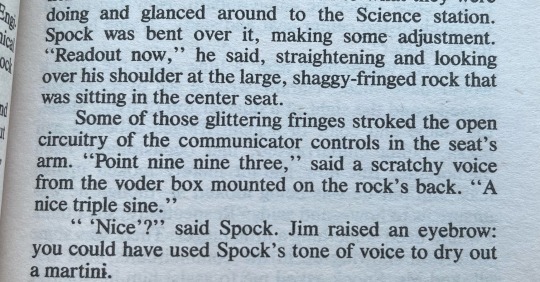
[Text ID: “Spock was bent over [the Science Station], making some adjustment. ‘Readout now,’ he said, straightening and looking over his shoulder at the large, shaggy-fringed rock that was sitting in the center seat. Some of those glittering fringes stroked the open circuitry of the communicator controls in the seat’s arm. ‘Point nine nine three,’ said a scratchy voice from the voder box mounted on the rock’s back. ‘A nice triple sine.’ ‘Nice?’ said Spock. Jim raised an eyebrow: you could have used Spock’s tone of voice to dry out a martini.” End ID]
There’s a Horta crewman on the Enterprise now and they’re great!

[Text ID: “Still working on her doctoral thesis, Jim thought. Uhura was busy working on improving universal translator theory, mostly by taking the old theory to pieces and putting it back together in shapes that were causing a terrible furor in academic circles on various planets. Jim vividly remembered one night quite a long time ago when he had asked Uhura exactly how she was going about this. She had told him, for almost an hour without stopping, and in delighted and exuberant detail, until his head was spinning with phoneme approximations and six-sigma evaluations and the syntactic fade and genderbend and recontextualization and linguistic structural design and the physics of the human dextrocerebral bridge. The session had left Jim shaking his head, thoroughly disabused of the idea (and ashamed of how long he had held it) that Uhura was simply a sort of highly trained switchboard operator.” End ID]
Uhura continues to be a total badass and is amazing at what she does.
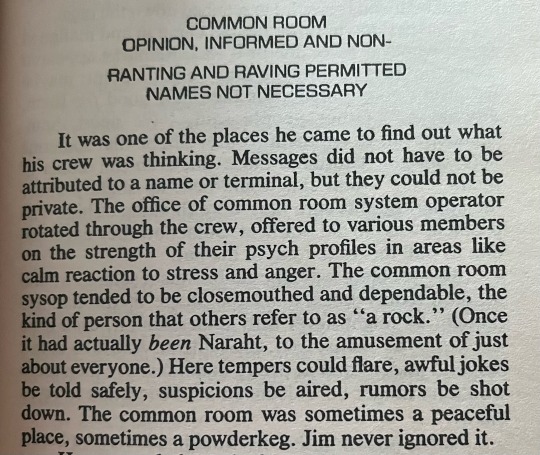
[Text ID: Chatroom title in all caps: “COMMON ROOM OPINION, INFORMED AND NON- RANTING AND RAVING PERMITTED NAMES NOT NECESSARY” Regular text: “It was one of the places he came to find out what his crew was thinking. Messages did not have to be attributed to a name or terminal, but they could not be private. The office of the common room system operator rotated through the crew, offered to various members on the strength of their psych profiles in areas like calm reaction to stress and anger. The common room syops tended to be closemouthed and dependable, the kind of person that others refer to as ‘a rock.’ (Once it had actually been Naraht, to the amusement of just about everyone.) Here tempers could flare, awful jokes be told safely, suspicions be aired, rumors be shot down. The common room was sometimes a peaceful place, sometimes a powderkeg. Jim never ignored it.” End ID]
The Enterprise has a dumpster fire chat room that has just as much shitposting and vitriol as twitter.
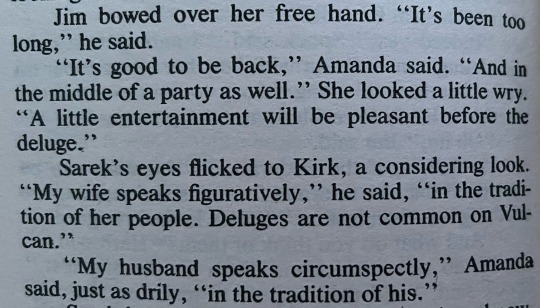
[Text ID: “Jim bowed over her free hand. ‘It’s been too long,’ he said. ‘It’s good to be back,’ Amanda said. ‘And in the middle of a party as well.’ She looked a little wry. ‘A little entertainment will be pleasant before the deluge.’ Sarek’s eyes flicked to Kirk, a considering look. ‘My wife speaks figuratively,’ he said, ‘in the tradition of her people. Deluges are not common on Vulcan.’ ‘My husband speaks circumspectly,’ Amanda said, just as dryly, ‘in the tradition of his.’” End ID]
Amanda and Sarek are as charming as ever.
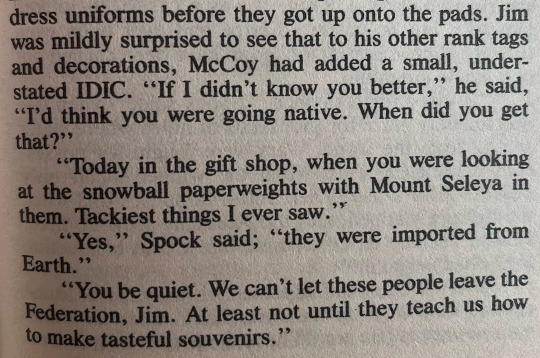
[Text ID: “Jim was mildly surprised to see that to his other rank tags and decorations, McCoy had added a small, understated IDIC. ‘If I didn’t know you better,’ he said, ‘I’d think you were going native. When did you get that?’ ‘Today in the gift shop, when you were looking at the snowball paperweights with Mount Seleya in them. Tackiest things I ever saw.’ ‘Yes,’ Spock said; ‘they were imported from Earth.’ ‘You be quiet. We can’t let these people leave the Federation, Jim. At least not until they teach us how to make tasteful souvenirs.’” End ID]
Just this.

[Text ID: “There was Sreil, the burly, brown-haired biologist from the Academy, and T’Madh, a little bright-eyed woman of great age and curiosity, a computer programmer; and her son Savesh, who when asked what he did, said, ‘I am a farmer,’ with a sort of secret satisfaction that hinted he thought his job better than any of the more technical ones that the people around him held. Jim had to smile; the thought of a Vulcan farmer was slightly funny, even though there naturally had to be some. But the image of a Vulcan in coveralls, chewing on a stalk of hay, kept coming up and having to be repressed.” End ID]
I love Savesh the Vulcan farmer!
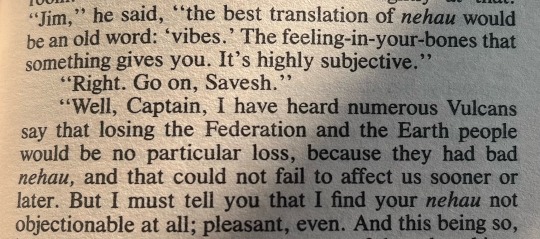
[Text ID: “’Jim,’ he said, ‘the best translation of nehau would be an old word: “vibes.” The feeling-in-your-bones that something gives you. It’s highly subjective.’ ‘Right. Go on, Savesh.’ ‘Well, Captain, I have heard numerous Vulcans say that losing the Federation and the Earth people would be no particular loss, because they had bad nehau, and that could not fail to affect us sooner or later.. But I must tell you that I find your nehau not objectionable at all; pleasant, even.’ End ID]
Vulcan wanting to leave the Federation because the ~vibes~ are off.
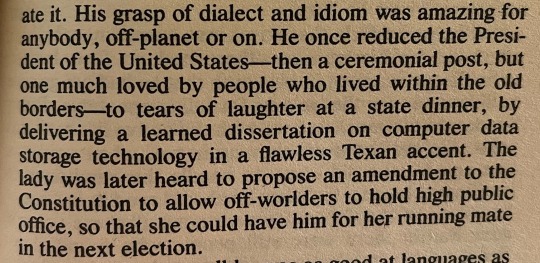
[Text ID: “His grasp of dialect and idiom as amazing for anybody, off-planet or on. He once reduced the President of the United States—then a ceremonial post, but one much loved by the people who lived within the old borders—to tears of laughter at a state dinner, by delivering a learned dissertation on computer data storage technology in a flawless Texan accent. The lady was later heard to propose an amendment to the Constitution to allow off-worlders to hold high public office, so that she could have him for her running mate in the next election.” End ID]
I would give anything to hear Sarek do a perfect Texas accent.
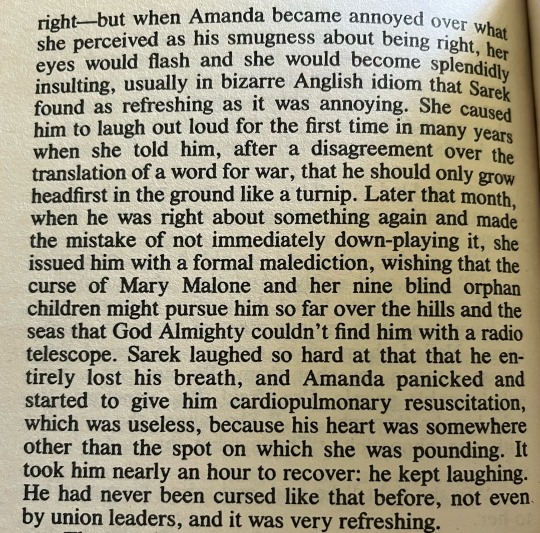
[Text ID: “—but when Amanda became annoyed over what she perceived as his smugness about being right, her eyes would flash and she would become splendidly insulting, usually in bizarre Anglish idiom that Sarek found as refreshing as it was annoying. She caused him to laugh out loud for the first time in many years when she told him, after a disagreement over the translation of the word for war, that he should only grow headfirst in the ground like a turnip. Later that month, when he was right about something again and made the mistake of not immediately down-playing it, she issued him with a formal malediction, wishing that the curse of Mary Malone and her nine blind orphan children might pursue him so far over the hills and the seas that God Almighty couldn’t find him with a radio telescope. Sarek laughed so hard at that that he entirely lost his breath, and Amanda panicked and started to give him cardiopulmonary resuscitation, which was useless, because his heart was somewhere other than the spot on which she was pounding. It took him nearly an hour to recover: he kept laughing. He had never been cursed like that before, not even by union leaders, and it was very refreshing.” End ID]
This dynamic is perfect, no notes.
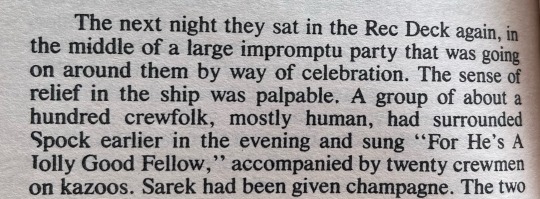
[Text ID: “The next night they sat in the Rec Deck again, in the middle of a large impromptu party that was going on around them by way of celebration. The sense of relief in the ship was palpable. A group of about a hundred crewfolk, mostly human, had surrounded Spock earlier in the evening and sung ‘For He’s A Jolly Good Fellow,’ accompanied by twenty crewmen on kazoos. Sarek had been given champagne.” End ID]
I really hope the TOS Enterprise has crew performances like on Next Gen. This kazoo band needs to be heard! Also, I can perfectly picture Spock’s annoyed-but-tolerant expression as he resigns himself to the kazoo serenade.
Thank you @dianeduane for making me laugh!
#star trek#star trek tos#spock’s world#diane duane#star trek books#star trek novels#spock#jim kirk#leonard mccoy#sarek#amanda grayson
985 notes
·
View notes
Text
i've been looking around to try and find resources for csl, and i think i've found another great one! i have yet to try it out (i'm very busy right now with getting settled into classes), but i found a course by the shanghai international studies university is offered through futurelearn for free! it covers word categories, linguistic features, syntactic structures, csl varieties, the distinction between csl and signed chinese, deaf culture, the history of csl, and deaf education and historical figures. it's six weeks long and four hours per week, and you can sign up for it here:
#langblr#sign language#chinese sign language#csl#language learning#langblr resources#resources#indigo ink
355 notes
·
View notes
Text
North East Asian style "head final with lots of participials" just feels so right to me, syntactically. I mean this is a consequence of learning Japanese, but it just sits in my head so well, it feels so natural and elegant. I know that not all languages make me feel this way, but I wonder if there are others that would? I think from what I know about Iroquoian that it might make me feel similarly, like the verb-centric structure would just click and then I would want to think certain thoughts in Iroquoian forever. I don't know, I don't really have cause or context to learn an Iroquoian language, but I'm definitely seriously considering learning Greenlandic. A very different flavor of polysenthesis but maybe it will have the same effect.
44 notes
·
View notes